
Cesar Dog Food Ingredients
According to our research, Cesar manufactures 75 dog food recipes using 177 unique ingredients. To evaluate the quality of ingredients used by Cesar, we've studied all 177 ingredients. In this article, we'll share our findings on Cesar ingredients.
| Dog Food Recipes | 75 |
| Unique Ingredients | 177 |
| Artificial Colors | 6 |
| Animal By-Products | 4 |
| Anonymous Meats | 5 |
| Controversial | 16 |
| Harmful | 8 |
First 5 Ingredients
Dog food ingredients in the United States are listed in descending order of pre-cooked weight. The first 5 ingredients typically constitute a significant portion of the recipe.
For Cesar, these are the most common ingredients found within the first 5 dog food ingredients.
- chicken
- chicken broth
- water
- chicken broth
- water
As you can see, the most common first ingredient in Cesar is chicken. The most common 2nd ingredient is chicken broth, followed by water, chicken broth, and water.
Artificial Food Coloring Dyes
Our records indicate that Cesar does use artificial food coloring dyes. More specifically, we've identified 6 artificial food dyes used by Cesar.
Although these food dyes are classified as Generally Recognized As Safe (GRAS) by the FDA, we recommend avoiding them when possible.
According to the Center For Research In The Public Interest (CSPI), there are many potential health risks associated with the consumption of artificial food coloring dyes.
Given that most pets consume the same products for prolonged periods of time, these concerns should be taken seriously. In general, we recommend pet owners avoid feeding products which contain artificial food coloring dyes.
For more information regarding the CSPI's findings, read our artificial food coloring article.
Red 40 is the most widely used artificial dye in consumer goods. Studies have shown that red 40 may accelerate the appearance of immune-system tumors in mice, cause allergy-like reactions and trigger hyperactivity in children.
The following recipes contain red 40:
Yellow 6 is an artificial food dye which may be contaminated with cancer-causing chemicals. According to the Center For Science In The Public Interest, yellow 6 can cause adrenal tumors in animals.
The following recipes contain yellow 6:
- Cesar Softies Medley Trio
- Cesar Softies Filet Mignon Flavor
- Cesar Softies Grilled Chicken Flavor
- Cesar Dry Dog Food Rotisserie Chicken Flavor
- Cesar Dry Dog Food Filet Mignon Flavor
- Cesar Dry Dog Food Porterhouse Flavor
- Cesar Home Delights Grilled Porterhouse Steak Flavor With Potatoes & Bacon In Sauce
- Cesar Home Delights Sausage Flavor With Egg & Cheese In Sauce
- Cesar Home Delights Scramble With Turkey, Spinach & Cheese In Sauce
- Cesar Home Delights T-Bone Steak, Egg & Cheese Flavor In Sauce
Blue 2 is an artificial dye which can increase the likelihood of tumors according to the Center for Science in the Public Interest. Like other dyes, blue 2 does not provide any nutritional value.
The following recipes contain blue 2:
Yellow 5 is an artificial dye which may be contaminated with several cancer-causing chemicals. Like other dyes, yellow 5 does not provide any nutritional value.
The following recipes contain yellow 5:
- Cesar Softies Medley Trio
- Cesar Softies Filet Mignon Flavor
- Cesar Softies Grilled Chicken Flavor
- Cesar Dry Dog Food Rotisserie Chicken Flavor
- Cesar Dry Dog Food Filet Mignon Flavor
- Cesar Dry Dog Food Porterhouse Flavor
- Cesar Home Delights Grilled Porterhouse Steak Flavor With Potatoes & Bacon In Sauce
- Cesar Home Delights Sausage Flavor With Egg & Cheese In Sauce
- Cesar Home Delights Scramble With Turkey, Spinach & Cheese In Sauce
- Cesar Home Delights T-Bone Steak, Egg & Cheese Flavor In Sauce
Red 3 is an artificial dye which the FDA has confirmed can cause cancer in laboratory animals.
The following recipes contain red 3:
- Cesar Loaf & Topper In Sauce Rotisserie Chicken Flavor With Bacon & Cheese
- Cesar Loaf & Topper In Sauce Filet Mignon Flavor With Bacon & Potato
- Cesar Loaf & Topper In Sauce Angus Beef Flavor With Bacon & Cheese
- Cesar Softies Medley Trio
- Cesar Home Delights Grilled Porterhouse Steak Flavor With Potatoes & Bacon In Sauce
The ingredient "added color" is ambiguous and may include various artificial dyes. Most artificial dyes have been linked to various chronic diseases.
The following recipes contain added color:
- Cesar Home Delights Pot Roast With Spring Vegetables Dinner In Sauce
- Cesar Home Delights Beef Stew
- Cesar Classic Loaf In Sauce Porterhouse Steak Flavor
- Cesar Classic Loaf In Sauce Filet Mignon Flavor
- Cesar Classic Loaf In Sauce Beef Recipe
- Cesar Classic Loaf In Sauce Top Sirloin Flavor
- Cesar Classic Loaf In Sauce Lamb Recipe
- Cesar Loaf & Topper In Sauce Rotisserie Chicken Flavor With Bacon & Cheese
- Cesar Loaf & Topper In Sauce Rosemary Chicken Flavor With Spring Vegetables
- Cesar Loaf & Topper In Sauce Filet Mignon Flavor With Bacon & Potato
- Cesar Loaf & Topper In Sauce Ham & Egg Flavor With Potato & Cheese
- Cesar Loaf & Topper In Sauce Angus Beef Flavor With Bacon & Cheese
- Cesar Filets In Sauce Filet Mignon Flavor
- Cesar Filets In Gravy Prime Rib Flavor
- Cesar Filets In Gravy New York Strip Flavor
- Cesar Classic Loaf In Sauce Grilled Steak & Eggs Flavor
- Cesar Classic Loaf In Sauce Lamb & Rice Recipe For Puppies
- Cesar Classic Loaf In Sauce Chicken & Beef Recipe For Puppies
- Cesar Classic Loaf In Sauce Duck Recipe
- Cesar Home Delights Grilled Porterhouse Steak Flavor With Potatoes & Bacon In Sauce
- Cesar Home Delights Grilled Ribeye Steak Flavor With Vegetables In Sauce
- Cesar Home Delights Grilled New York Strip Steak Flavor With Vegetables In Sauce
- Cesar Home Delights Sausage Flavor With Egg & Cheese In Sauce
- Cesar Home Delights Scramble With Turkey, Spinach & Cheese In Sauce
- Cesar Home Delights T-Bone Steak, Egg & Cheese Flavor In Sauce
- Cesar Home Delights Chicken & Turkey Casserole In Sauce
- Cesar Home Delights Harvest Potluck With Turkey In Gravy
- Cesar Classic Loaf In Sauce Dry-Aged Ribeye Flavor
Animal By-Products
Cesar does indeed use animal by-products. More specifically, 4 animal by-product ingredients were found during our analysis of Cesar dog food ingredients.
According to AAFCO, by-products are defined as the non-rendered, clean parts, other than meat, derived from slaughtered mammals. In other words, animal by-products are the leftover ingredients that humans typically do not consume (lung, heart, tongue, stomach, intestine, blood, etc).
Many consumers have equated animal by-products with slaughterhouse waste. Animal by-products are still very controversial. Most premium brands have abandoned them in favor of specific named organ ingredients (duck liver, chicken heart, etc).
If you must feed a product with animal by-products, ensure that the specific animal source is specified. In other words, avoid ingredients such as meat by-products or poultry by-products.
By-products are defined by AAFCO as the "non-rendered, clean parts, other than meat, derived from slaughtered mammals." Thus, meat by-products contain nearly all parts of the animal which are typically not consumed by humans. These parts include the liver, lung, spleen, kidney, stomach, blood, intestine, bone, etc.
This ingredient is marked controversial because the meat source is not identified. Anonymous ingredients such as meat by-products are typically very low quality additions. The most unpleasing property of this ingredient is that the animal source can contain any mammal, even dogs & cats.
The following recipes contain meat by-products:
By-products are defined by AAFCO as the "non-rendered, clean parts, other than meat, derived from slaughtered mammals." Thus, pork by-products contain nearly all parts of pork which are typically not consumed by humans. These parts include the liver, lung, spleen, kidney, stomach, blood, intestine, bone, etc.
Like other meat by-products, pork by-products are considered controversial, mainly because they are inexpensive ingredients which consumers have equated with slaughterhouse waste. However, manufactures and many experts claim that animal by-products are unjustly criticized. Proponents state that "named" by-products, such as pork by-products, supply many important nutrients required by dogs.
The following recipes contain pork by-products:
- Cesar Classic Loaf In Sauce Chicken & Beef Recipe
- Cesar Classic Loaf In Sauce Porterhouse Steak Flavor
- Cesar Classic Loaf In Sauce Filet Mignon Flavor
- Cesar Classic Loaf In Sauce Beef Recipe
- Cesar Classic Loaf In Sauce Top Sirloin Flavor
- Cesar Classic Loaf In Sauce Lamb Recipe
- Cesar Loaf & Topper In Sauce Rotisserie Chicken Flavor With Bacon & Cheese
- Cesar Loaf & Topper In Sauce Rosemary Chicken Flavor With Spring Vegetables
- Cesar Loaf & Topper In Sauce Filet Mignon Flavor With Bacon & Potato
- Cesar Loaf & Topper In Sauce Ham & Egg Flavor With Potato & Cheese
- Cesar Loaf & Topper In Sauce Angus Beef Flavor With Bacon & Cheese
- Cesar Classic Loaf In Sauce Smoked Bacon & Egg Flavor
- Cesar Classic Loaf In Sauce Grilled Steak & Eggs Flavor
- Cesar Classic Loaf In Sauce Scrambled Egg & Sausage Flavor
- Cesar Classic Loaf In Sauce Grilled Chicken Flavor
- Cesar Classic Loaf In Sauce Chicken & Liver Recipe
- Cesar Classic Loaf In Sauce Chicken & Veal Recipe
- Cesar Classic Loaf In Sauce Turkey Recipe
- Cesar Classic Loaf In Sauce Duck Recipe
- Cesar Classic Loaf In Sauce Oven Roasted Chicken Flavor
- Cesar Classic Loaf In Sauce Dry-Aged Ribeye Flavor
Chicken by-product meal is produced by cooking chicken by-products using a process called rendering. By-products are defined by AAFCO as the "non-rendered, clean parts, other than meat, derived from slaughtered mammals." Thus, chicken by-products contain nearly all parts of chickens which are typically not consumed by humans. These parts include the liver, lung, spleen, kidney, stomach, blood, intestine, bone, etc.
Like other meat by-products, chicken by-products are considered controversial, mainly because they are inexpensive ingredients which consumers have equated with slaughterhouse waste. However, manufactures and many experts claim that animal by-products are unjustly criticized. Proponents state that "named" by-products, such as chicken by-products, supply many important nutrients required by dogs.
The following recipes contain chicken by-product meal:
By-products are defined by AAFCO as the "non-rendered, clean parts, other than meat, derived from slaughtered mammals." Thus, beef by-products contain nearly all parts of the beef which are typically not consumed by humans. These parts include the liver, lung, spleen, kidney, stomach, blood, intestine, bone, etc.
Like other meat by-products, beef by-products are considered controversial, mainly because they are inexpensive ingredients which consumers have equated with slaughterhouse waste. However, manufactures and many experts claim that animal by-products are unjustly criticized. Proponents state that "named" by-products, such as beef by-products, supply many important nutrients required by dogs.
The following recipes contain beef by-products:
Anonymous Meat Ingredients
Anonymous meats are animal-based ingredients which do not provide the source animal's name. These ingredients are controversial because they can come from almost any animal.
In addition, anonymous animal-based ingredients are very inexpensive and often the lowest quality meats that are still allowed to be used in pet food.
In general, we do not recommend feeding any products which contain anonymous meats. When in doubt, always contact the brand's customer service desk for further clarification.
Unfortunately, we've identified 5 anonymous meat ingredients used by Cesar.
Animal fat is a by-product of tissue rendering. The source animal is not specific and therefore we cannot be certain that the source does not include diseased animals or even euthanized dogs and cats. What's more, this ingredient is preserved with BHA, an artificial preservative and possible carcinogen according to the World Health Organization.
The following recipes contain animal fat (preserved with BHA and citric acid):
Meat and bone meal is produced by cooking meat and bone using a process called rendering. The rendering process dramatically reduces the natural moisture of meat and thereby results in a highly condensed protein source.
This ingredient is marked controversial because the source animal for the meat is not specified. These type of anonymous ingredient are typically very low quality and certainly inexpensive additions. The most unpleasing property of this ingredient is that the meat source can contain any mammal, even dogs & cats.
The following recipes contain meat and bone meal:
By-products are defined by AAFCO as the "non-rendered, clean parts, other than meat, derived from slaughtered mammals." Thus, meat by-products contain nearly all parts of the animal which are typically not consumed by humans. These parts include the liver, lung, spleen, kidney, stomach, blood, intestine, bone, etc.
This ingredient is marked controversial because the meat source is not identified. Anonymous ingredients such as meat by-products are typically very low quality additions. The most unpleasing property of this ingredient is that the animal source can contain any mammal, even dogs & cats.
The following recipes contain meat by-products:
Animal plasma can be a nutritious addition to pet food, however, the source should be specified. In this case, the animal source is not specified and therefore we cannot determine which animal was used to obtain the plasma.
The following recipes contain animal plasma:
- Cesar Home Delights Pot Roast With Spring Vegetables Dinner In Sauce
- Cesar Home Delights Slow Cooked Chicken & Vegetables Dinner In Sauce
- Cesar Home Delights Beef Stew
- Cesar Home Delights Hearty Chicken & Noodle Dinner In Sauce
- Cesar Home Delights Turkey, Green Beans & Potatoes Dinner In Sauce
- Cesar Filets In Sauce Filet Mignon Flavor
- Cesar Filets In Gravy Prime Rib Flavor
- Cesar Home Delights Grilled Porterhouse Steak Flavor With Potatoes & Bacon In Sauce
- Cesar Home Delights Grilled Ribeye Steak Flavor With Vegetables In Sauce
- Cesar Home Delights Grilled New York Strip Steak Flavor With Vegetables In Sauce
- Cesar Home Delights Sausage Flavor With Egg & Cheese In Sauce
- Cesar Home Delights Scramble With Turkey, Spinach & Cheese In Sauce
- Cesar Home Delights T-Bone Steak, Egg & Cheese Flavor In Sauce
- Cesar Home Delights Chicken & Turkey Casserole In Sauce
- Cesar Home Delights Harvest Potluck With Turkey In Gravy
- Cesar Filets In Gravy Turkey Recipe
- Cesar Filets In Gravy Rotisserie Chicken Flavor
- Cesar Minis Slow Cooked Chicken & Vegetables Dinner Filets In Gravy
- Cesar Minis Grilled Chicken Flavor With Vegetables Filets In Gravy
- Cesar Home Delights BBQ Chicken Flavor With Green Beans & Orzo In Sauce
- Cesar Home Delights Braised Rib Flavor With Carrots & Peas In Sauce
Animal fat is a by-product of tissue rendering. The source animal is not specific and therefore we cannot be certain that the source does not include diseased animals or even euthanized dogs and cats. What's more, this ingredient is preserved with BHA/BHT, both artificial preservatives and possible carcinogens according to the World Health Organization.
The following recipes contain animal fat (preserved with BHA/BHT):
Controversial Ingredients
In most cases, ingredients which are given the controversial classification can be substituted with higher-quality alternatives. You should evaluate each controversial ingredient independently to see if there is truly a valid cause for concern.
Keep in mind, certain sacrifices often must be made to produce dog foods at a reasonable price. In general, the more expensive the product, the fewer controversial ingredients you'll find.
In our analysis, we've identified 16 controversial ingredients inside Cesar products. These controversial ingredients are listed below. Click on each ingredient for more information.
Soybean flour contains more than 50% protein. Therefore, soybean can significantly boost the protein content of the product. The inclusion of non-meat protein typically degrades the overall quality of protein in the recipe. This degradation is due to the inferior amino acid profile of plant based proteins.
The following recipes contain soybean flour:
Powdered cellulose is produced from minuscule pieces of wood pulp and plant fibers. Other than its fiber content, powdered cellulose lacks any nutritional contribution.
The following recipes contain powdered cellulose:
- Cesar Wholesome Bowls Chicken, Carrots, Barley & Green Beans Recipe
- Cesar Wholesome Bowls Chicken Recipe
- Cesar Wholesome Bowls Chicken, Sweet Potatoes & Green Beans Recipe
- Cesar Wholesome Bowls Beef, Chicken, Carrots & Purple Potatoes Recipe
- Cesar Wholesome Bowls Beef, Chicken, Carrots, Barley & Green Beans Recipe
- Cesar Wholesome Bowls Chicken, Apple & Sweet Potato Recipe
- Cesar Filets In Gravy Wood-Grilled Chicken Flavor
Meat and bone meal is produced by cooking meat and bone using a process called rendering. The rendering process dramatically reduces the natural moisture of meat and thereby results in a highly condensed protein source.
This ingredient is marked controversial because the source animal for the meat is not specified. These type of anonymous ingredient are typically very low quality and certainly inexpensive additions. The most unpleasing property of this ingredient is that the meat source can contain any mammal, even dogs & cats.
The following recipes contain meat and bone meal:
Corn gluten meal is a by-product from the production of various corn products (corn starch, corn syrup, etc). It's very high in protein (nearly 60% protein) and therefore can significant boost the protein content of the product. Because plant based proteins such as corn gluten meal are inferior to meat based proteins (lack many essential amino acids), they are not suitable substitutes.
The following recipes contain corn gluten meal:
Brewer's rice is the small fragments of rice kernel that are separated from the larger kernels of milled rice. The fragments do not contain the same nutrition profile of the whole kernel and therefore brewer's rice is a lower quality grain. Brewer's rice is typically regarded as an inexpensive and low quality filler.
The following recipes contain brewers rice:
Wheat is regarded as an inexpensive and low-quality filler in pet food. However, wheat does provide plant-based protein and makes pet food more affordable for consumers. It's important to note that plant based protein does not provide the same amino acid profile as meat based protein.
The following recipes contain wheat:
Ground wheat is regarded as an inexpensive and low-quality filler in pet food. However, wheat does provide plant-based protein and makes pet food more affordable for consumers. It's important to note that plant based protein does not provide the same amino acid profile as meat based protein.
The following recipes contain ground wheat:
Wheat gluten is the main protein of wheat. Although wheat gluten is mostly protein, wheat gluten is considered controversial because it significantly boosts the protein content of the product. This is undesirable because plant based protein does not provide the same amino acid profile as meat based protein.
The following recipes contain wheat gluten:
- Cesar Home Delights Pot Roast With Spring Vegetables Dinner In Sauce
- Cesar Home Delights Slow Cooked Chicken & Vegetables Dinner In Sauce
- Cesar Home Delights Beef Stew
- Cesar Home Delights Hearty Chicken & Noodle Dinner In Sauce
- Cesar Home Delights Turkey, Green Beans & Potatoes Dinner In Sauce
- Cesar Filets In Sauce Filet Mignon Flavor
- Cesar Filets In Gravy Prime Rib Flavor
- Cesar Filets In Gravy New York Strip Flavor
- Cesar Home Delights Grilled Porterhouse Steak Flavor With Potatoes & Bacon In Sauce
- Cesar Home Delights Grilled Ribeye Steak Flavor With Vegetables In Sauce
- Cesar Home Delights Grilled New York Strip Steak Flavor With Vegetables In Sauce
- Cesar Home Delights Sausage Flavor With Egg & Cheese In Sauce
- Cesar Home Delights Scramble With Turkey, Spinach & Cheese In Sauce
- Cesar Home Delights T-Bone Steak, Egg & Cheese Flavor In Sauce
- Cesar Home Delights Chicken & Turkey Casserole In Sauce
- Cesar Home Delights Harvest Potluck With Turkey In Gravy
- Cesar Minis Slow Cooked Chicken & Vegetables Dinner Filets In Gravy
- Cesar Minis Grilled Chicken Flavor With Vegetables Filets In Gravy
- Cesar Home Delights BBQ Chicken Flavor With Green Beans & Orzo In Sauce
- Cesar Home Delights Braised Rib Flavor With Carrots & Peas In Sauce
Whole grain corn is the entire corn kernel (the germ, bran, and endosperm). Corn is a cereal grain which provides a modest amount of vitamins, minerals, and plant based protein. It also happens to be one of the most controversial ingredients in dog food.
Proponents of corn claim that corn is highly digestible and an excellent source of protein, energy, vitamins, minerals, and essential fatty acids.
Opponents however believe that positive claims in regards to corn are either half-truths or completely false, we'll discuss a few of the opposing arguments.
In regards to digestibility, the claims of "highly digestible" are only true if corn is processed into a meal or flour and subsequently cooked. In regards to the protein contribution, we must note that corn is a plant based protein which does not contain all of the necessary amino acids required by dogs to sustain life. Therefore substituting corn for meat is an unsuitable substitution and actually degrades the overall protein quality of the product.
Finally, we'll discuss the claims about vitamins and minerals in corn. Although corn does provide many vitamins and minerals, it not necessarily an exceptional ingredient in this regards. There are many other ingredients which are more complete and biologically appropriate. Therefore the usage of corn as the primary ingredient in dog food should certainly warrant further questioning.
The following recipes contain whole grain corn:
Caramel color is a concentrated form of caramel, a natural food colorant. Caramel color has been linked to cancer in laboratory animals. Since our pets do not care about food color, caramel color is an unnecessary addition with possible health risks.
The following recipes contain caramel color:
Liver is a controversial ingredient because the source animal is not specified. Anonymous animal ingredients are typically very low quality and may contain almost any animal, including dogs and cats!
The following recipes contain liver:
By-products are defined by AAFCO as the "non-rendered, clean parts, other than meat, derived from slaughtered mammals." Thus, meat by-products contain nearly all parts of the animal which are typically not consumed by humans. These parts include the liver, lung, spleen, kidney, stomach, blood, intestine, bone, etc.
This ingredient is marked controversial because the meat source is not identified. Anonymous ingredients such as meat by-products are typically very low quality additions. The most unpleasing property of this ingredient is that the animal source can contain any mammal, even dogs & cats.
The following recipes contain meat by-products:
Animal plasma can be a nutritious addition to pet food, however, the source should be specified. In this case, the animal source is not specified and therefore we cannot determine which animal was used to obtain the plasma.
The following recipes contain animal plasma:
- Cesar Home Delights Pot Roast With Spring Vegetables Dinner In Sauce
- Cesar Home Delights Slow Cooked Chicken & Vegetables Dinner In Sauce
- Cesar Home Delights Beef Stew
- Cesar Home Delights Hearty Chicken & Noodle Dinner In Sauce
- Cesar Home Delights Turkey, Green Beans & Potatoes Dinner In Sauce
- Cesar Filets In Sauce Filet Mignon Flavor
- Cesar Filets In Gravy Prime Rib Flavor
- Cesar Home Delights Grilled Porterhouse Steak Flavor With Potatoes & Bacon In Sauce
- Cesar Home Delights Grilled Ribeye Steak Flavor With Vegetables In Sauce
- Cesar Home Delights Grilled New York Strip Steak Flavor With Vegetables In Sauce
- Cesar Home Delights Sausage Flavor With Egg & Cheese In Sauce
- Cesar Home Delights Scramble With Turkey, Spinach & Cheese In Sauce
- Cesar Home Delights T-Bone Steak, Egg & Cheese Flavor In Sauce
- Cesar Home Delights Chicken & Turkey Casserole In Sauce
- Cesar Home Delights Harvest Potluck With Turkey In Gravy
- Cesar Filets In Gravy Turkey Recipe
- Cesar Filets In Gravy Rotisserie Chicken Flavor
- Cesar Minis Slow Cooked Chicken & Vegetables Dinner Filets In Gravy
- Cesar Minis Grilled Chicken Flavor With Vegetables Filets In Gravy
- Cesar Home Delights BBQ Chicken Flavor With Green Beans & Orzo In Sauce
- Cesar Home Delights Braised Rib Flavor With Carrots & Peas In Sauce
By-products are defined by AAFCO as the "non-rendered, clean parts, other than meat, derived from slaughtered mammals." Thus, pork by-products contain nearly all parts of pork which are typically not consumed by humans. These parts include the liver, lung, spleen, kidney, stomach, blood, intestine, bone, etc.
Like other meat by-products, pork by-products are considered controversial, mainly because they are inexpensive ingredients which consumers have equated with slaughterhouse waste. However, manufactures and many experts claim that animal by-products are unjustly criticized. Proponents state that "named" by-products, such as pork by-products, supply many important nutrients required by dogs.
The following recipes contain pork by-products:
- Cesar Classic Loaf In Sauce Chicken & Beef Recipe
- Cesar Classic Loaf In Sauce Porterhouse Steak Flavor
- Cesar Classic Loaf In Sauce Filet Mignon Flavor
- Cesar Classic Loaf In Sauce Beef Recipe
- Cesar Classic Loaf In Sauce Top Sirloin Flavor
- Cesar Classic Loaf In Sauce Lamb Recipe
- Cesar Loaf & Topper In Sauce Rotisserie Chicken Flavor With Bacon & Cheese
- Cesar Loaf & Topper In Sauce Rosemary Chicken Flavor With Spring Vegetables
- Cesar Loaf & Topper In Sauce Filet Mignon Flavor With Bacon & Potato
- Cesar Loaf & Topper In Sauce Ham & Egg Flavor With Potato & Cheese
- Cesar Loaf & Topper In Sauce Angus Beef Flavor With Bacon & Cheese
- Cesar Classic Loaf In Sauce Smoked Bacon & Egg Flavor
- Cesar Classic Loaf In Sauce Grilled Steak & Eggs Flavor
- Cesar Classic Loaf In Sauce Scrambled Egg & Sausage Flavor
- Cesar Classic Loaf In Sauce Grilled Chicken Flavor
- Cesar Classic Loaf In Sauce Chicken & Liver Recipe
- Cesar Classic Loaf In Sauce Chicken & Veal Recipe
- Cesar Classic Loaf In Sauce Turkey Recipe
- Cesar Classic Loaf In Sauce Duck Recipe
- Cesar Classic Loaf In Sauce Oven Roasted Chicken Flavor
- Cesar Classic Loaf In Sauce Dry-Aged Ribeye Flavor
Chicken by-product meal is produced by cooking chicken by-products using a process called rendering. By-products are defined by AAFCO as the "non-rendered, clean parts, other than meat, derived from slaughtered mammals." Thus, chicken by-products contain nearly all parts of chickens which are typically not consumed by humans. These parts include the liver, lung, spleen, kidney, stomach, blood, intestine, bone, etc.
Like other meat by-products, chicken by-products are considered controversial, mainly because they are inexpensive ingredients which consumers have equated with slaughterhouse waste. However, manufactures and many experts claim that animal by-products are unjustly criticized. Proponents state that "named" by-products, such as chicken by-products, supply many important nutrients required by dogs.
The following recipes contain chicken by-product meal:
By-products are defined by AAFCO as the "non-rendered, clean parts, other than meat, derived from slaughtered mammals." Thus, beef by-products contain nearly all parts of the beef which are typically not consumed by humans. These parts include the liver, lung, spleen, kidney, stomach, blood, intestine, bone, etc.
Like other meat by-products, beef by-products are considered controversial, mainly because they are inexpensive ingredients which consumers have equated with slaughterhouse waste. However, manufactures and many experts claim that animal by-products are unjustly criticized. Proponents state that "named" by-products, such as beef by-products, supply many important nutrients required by dogs.
The following recipes contain beef by-products:
Potentially Harmful Ingredients
Harmful ingredients are those which have been linked to adverse health effects. In general, we do not recommend feeding any product which contains any harmful ingredients.
There are certain situations where these ingredients may be necessary. We always recommend contacting Cesar for further clarification regarding any harmful or controversial ingredient.
We have identified 8 harmful ingredients used in certain Cesar recipes. To learn more, click on the ingredient's name.
Animal fat is a by-product of tissue rendering. The source animal is not specific and therefore we cannot be certain that the source does not include diseased animals or even euthanized dogs and cats. What's more, this ingredient is preserved with BHA, an artificial preservative and possible carcinogen according to the World Health Organization.
The following recipes contain animal fat (preserved with BHA and citric acid):
Red 40 is the most widely used artificial dye in consumer goods. Studies have shown that red 40 may accelerate the appearance of immune-system tumors in mice, cause allergy-like reactions and trigger hyperactivity in children.
The following recipes contain red 40:
Yellow 6 is an artificial food dye which may be contaminated with cancer-causing chemicals. According to the Center For Science In The Public Interest, yellow 6 can cause adrenal tumors in animals.
The following recipes contain yellow 6:
- Cesar Softies Medley Trio
- Cesar Softies Filet Mignon Flavor
- Cesar Softies Grilled Chicken Flavor
- Cesar Dry Dog Food Rotisserie Chicken Flavor
- Cesar Dry Dog Food Filet Mignon Flavor
- Cesar Dry Dog Food Porterhouse Flavor
- Cesar Home Delights Grilled Porterhouse Steak Flavor With Potatoes & Bacon In Sauce
- Cesar Home Delights Sausage Flavor With Egg & Cheese In Sauce
- Cesar Home Delights Scramble With Turkey, Spinach & Cheese In Sauce
- Cesar Home Delights T-Bone Steak, Egg & Cheese Flavor In Sauce
Blue 2 is an artificial dye which can increase the likelihood of tumors according to the Center for Science in the Public Interest. Like other dyes, blue 2 does not provide any nutritional value.
The following recipes contain blue 2:
Yellow 5 is an artificial dye which may be contaminated with several cancer-causing chemicals. Like other dyes, yellow 5 does not provide any nutritional value.
The following recipes contain yellow 5:
- Cesar Softies Medley Trio
- Cesar Softies Filet Mignon Flavor
- Cesar Softies Grilled Chicken Flavor
- Cesar Dry Dog Food Rotisserie Chicken Flavor
- Cesar Dry Dog Food Filet Mignon Flavor
- Cesar Dry Dog Food Porterhouse Flavor
- Cesar Home Delights Grilled Porterhouse Steak Flavor With Potatoes & Bacon In Sauce
- Cesar Home Delights Sausage Flavor With Egg & Cheese In Sauce
- Cesar Home Delights Scramble With Turkey, Spinach & Cheese In Sauce
- Cesar Home Delights T-Bone Steak, Egg & Cheese Flavor In Sauce
Red 3 is an artificial dye which the FDA has confirmed can cause cancer in laboratory animals.
The following recipes contain red 3:
- Cesar Loaf & Topper In Sauce Rotisserie Chicken Flavor With Bacon & Cheese
- Cesar Loaf & Topper In Sauce Filet Mignon Flavor With Bacon & Potato
- Cesar Loaf & Topper In Sauce Angus Beef Flavor With Bacon & Cheese
- Cesar Softies Medley Trio
- Cesar Home Delights Grilled Porterhouse Steak Flavor With Potatoes & Bacon In Sauce
The ingredient "added color" is ambiguous and may include various artificial dyes. Most artificial dyes have been linked to various chronic diseases.
The following recipes contain added color:
- Cesar Home Delights Pot Roast With Spring Vegetables Dinner In Sauce
- Cesar Home Delights Beef Stew
- Cesar Classic Loaf In Sauce Porterhouse Steak Flavor
- Cesar Classic Loaf In Sauce Filet Mignon Flavor
- Cesar Classic Loaf In Sauce Beef Recipe
- Cesar Classic Loaf In Sauce Top Sirloin Flavor
- Cesar Classic Loaf In Sauce Lamb Recipe
- Cesar Loaf & Topper In Sauce Rotisserie Chicken Flavor With Bacon & Cheese
- Cesar Loaf & Topper In Sauce Rosemary Chicken Flavor With Spring Vegetables
- Cesar Loaf & Topper In Sauce Filet Mignon Flavor With Bacon & Potato
- Cesar Loaf & Topper In Sauce Ham & Egg Flavor With Potato & Cheese
- Cesar Loaf & Topper In Sauce Angus Beef Flavor With Bacon & Cheese
- Cesar Filets In Sauce Filet Mignon Flavor
- Cesar Filets In Gravy Prime Rib Flavor
- Cesar Filets In Gravy New York Strip Flavor
- Cesar Classic Loaf In Sauce Grilled Steak & Eggs Flavor
- Cesar Classic Loaf In Sauce Lamb & Rice Recipe For Puppies
- Cesar Classic Loaf In Sauce Chicken & Beef Recipe For Puppies
- Cesar Classic Loaf In Sauce Duck Recipe
- Cesar Home Delights Grilled Porterhouse Steak Flavor With Potatoes & Bacon In Sauce
- Cesar Home Delights Grilled Ribeye Steak Flavor With Vegetables In Sauce
- Cesar Home Delights Grilled New York Strip Steak Flavor With Vegetables In Sauce
- Cesar Home Delights Sausage Flavor With Egg & Cheese In Sauce
- Cesar Home Delights Scramble With Turkey, Spinach & Cheese In Sauce
- Cesar Home Delights T-Bone Steak, Egg & Cheese Flavor In Sauce
- Cesar Home Delights Chicken & Turkey Casserole In Sauce
- Cesar Home Delights Harvest Potluck With Turkey In Gravy
- Cesar Classic Loaf In Sauce Dry-Aged Ribeye Flavor
Animal fat is a by-product of tissue rendering. The source animal is not specific and therefore we cannot be certain that the source does not include diseased animals or even euthanized dogs and cats. What's more, this ingredient is preserved with BHA/BHT, both artificial preservatives and possible carcinogens according to the World Health Organization.
The following recipes contain animal fat (preserved with BHA/BHT):
Cesar Dog Food Ingredient Lists
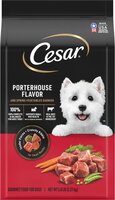
Cesar
Dry Dog Food
Porterhouse Flavor
Cesar
Dry Dog Food Porterhouse Flavor
First Five Ingredients
beefground wheat
meat and bone meal
whole grain corn
brewers rice
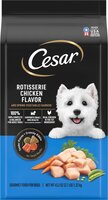
Cesar
Dry Dog Food
Rotisserie Chicken Flavor
Cesar
Dry Dog Food Rotisserie Chicken Flavor
First Five Ingredients
chickenwhole grain corn
ground wheat
meat and bone meal
brewers rice
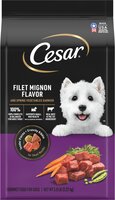
Cesar
Dry Dog Food
Filet Mignon Flavor
Cesar
Dry Dog Food Filet Mignon Flavor
First Five Ingredients
beefground wheat
meat and bone meal
whole grain corn
brewers rice
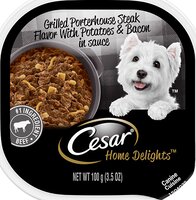
Cesar
Home Delights
Grilled Porterhouse Steak Flavor With Potatoes & Bacon In Sauce
Cesar
Home Delights Grilled Porterhouse Steak Flavor With Potatoes & Bacon In Sauce
First Five Ingredients
water sufficient for processingchicken
water
chicken liver
wheat gluten
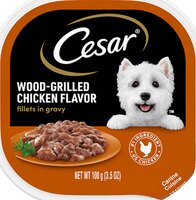
Cesar
Filets In Gravy
Wood-Grilled Chicken Flavor
Cesar
Filets In Gravy Wood-Grilled Chicken Flavor
First Five Ingredients
chickenwater
soybean oil
tapioca starch
powdered cellulose
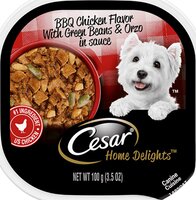
Cesar
Home Delights
BBQ Chicken Flavor With Green Beans & Orzo In Sauce
Cesar
Home Delights BBQ Chicken Flavor With Green Beans & Orzo In Sauce
First Five Ingredients
chickenchicken broth
water
green bean
chicken liver
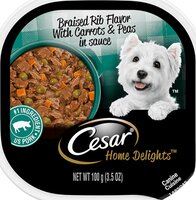
Cesar
Home Delights
Braised Rib Flavor With Carrots & Peas In Sauce
Cesar
Home Delights Braised Rib Flavor With Carrots & Peas In Sauce
First Five Ingredients
porkchicken broth
water
carrot
chicken
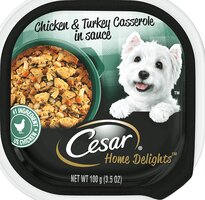
Cesar
Home Delights
Chicken & Turkey Casserole In Sauce
Cesar
Home Delights Chicken & Turkey Casserole In Sauce
First Five Ingredients
chickenchicken broth
water
carrot
chicken liver

Cesar
Home Delights
Hearty Chicken & Noodle Dinner In Sauce
Cesar
Home Delights Hearty Chicken & Noodle Dinner In Sauce
First Five Ingredients
chickenchicken broth
water
chicken liver
green bean
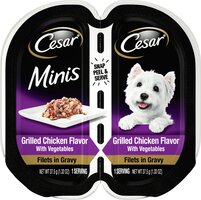
Cesar
Minis
Grilled Chicken Flavor With Vegetables Filets In Gravy
Cesar
Minis Grilled Chicken Flavor With Vegetables Filets In Gravy
First Five Ingredients
chickenchicken broth
water
carrot
chicken liver
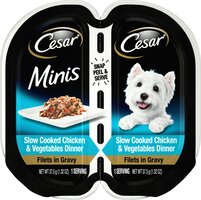
Cesar
Minis
Slow Cooked Chicken & Vegetables Dinner Filets In Gravy
Cesar
Minis Slow Cooked Chicken & Vegetables Dinner Filets In Gravy
First Five Ingredients
chickenchicken broth
water
carrot
green bean
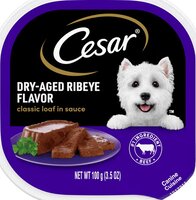
Cesar
Classic Loaf In Sauce
Dry-Aged Ribeye Flavor
Cesar
Classic Loaf In Sauce Dry-Aged Ribeye Flavor
First Five Ingredients
beefchicken liver
beef lung
chicken broth
water
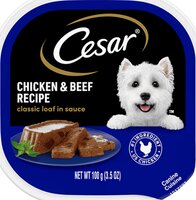
Cesar
Classic Loaf In Sauce
Chicken & Beef Recipe
Cesar
Classic Loaf In Sauce Chicken & Beef Recipe
First Five Ingredients
chickenchicken liver
beef lung
chicken broth
water
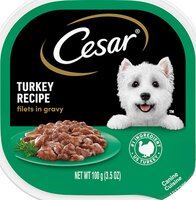
Cesar
Filets In Gravy
Turkey Recipe
Cesar
Filets In Gravy Turkey Recipe
First Five Ingredients
turkeychicken broth
water
chicken
chicken liver

Cesar
Fresh Chef
Beef & Chicken Recipe
Cesar
Fresh Chef Beef & Chicken Recipe
First Five Ingredients
beefchicken
beef broth
beef liver
pea

Cesar
Fresh Chef
Chicken Recipe
Cesar
Fresh Chef Chicken Recipe
First Five Ingredients
chickenchicken broth
chicken liver
pea
carrot
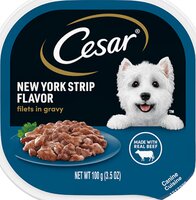
Cesar
Filets In Gravy
New York Strip Flavor
Cesar
Filets In Gravy New York Strip Flavor
First Five Ingredients
waterchicken
liver
beef
meat by-products
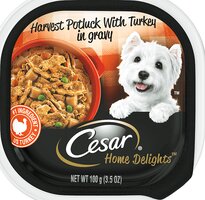
Cesar
Home Delights
Harvest Potluck With Turkey In Gravy
Cesar
Home Delights Harvest Potluck With Turkey In Gravy
First Five Ingredients
turkeychicken broth
water
chicken
potato
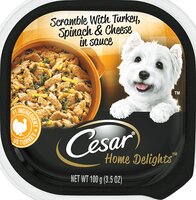
Cesar
Home Delights
Scramble With Turkey, Spinach & Cheese In Sauce
Cesar
Home Delights Scramble With Turkey, Spinach & Cheese In Sauce
First Five Ingredients
turkeychicken broth
water
spinach
chicken
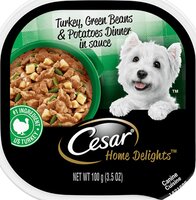
Cesar
Home Delights
Turkey, Green Beans & Potatoes Dinner In Sauce
Cesar
Home Delights Turkey, Green Beans & Potatoes Dinner In Sauce
First Five Ingredients
turkeychicken broth
water
green bean
chicken
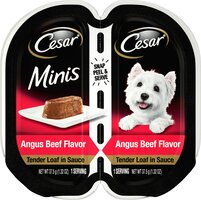
Cesar
Minis
Angus Beef Flavor Tender Loaf In Sauce
Cesar
Minis Angus Beef Flavor Tender Loaf In Sauce
First Five Ingredients
beefchicken
chicken liver
chicken broth
water
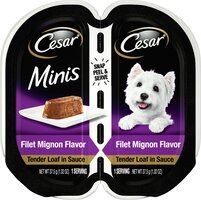
Cesar
Minis
Filet Mignon Flavor Tender Loaf In Sauce
Cesar
Minis Filet Mignon Flavor Tender Loaf In Sauce
First Five Ingredients
beefchicken
chicken liver
chicken broth
water
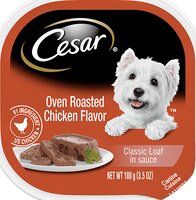
Cesar
Classic Loaf In Sauce
Oven Roasted Chicken Flavor
Cesar
Classic Loaf In Sauce Oven Roasted Chicken Flavor
First Five Ingredients
chickenchicken liver
beef lung
chicken broth
water
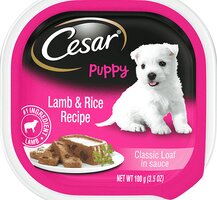
Cesar
Classic Loaf In Sauce
Lamb & Rice Recipe For Puppies
Cesar
Classic Loaf In Sauce Lamb & Rice Recipe For Puppies
First Five Ingredients
lambchicken liver
beef lung
beef by-products
chicken broth
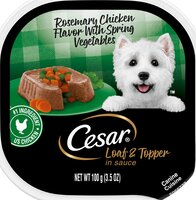
Cesar
Loaf & Topper In Sauce
Rosemary Chicken Flavor With Spring Vegetables
Cesar
Loaf & Topper In Sauce Rosemary Chicken Flavor With Spring Vegetables
First Five Ingredients
chickenchicken broth
water
chicken liver
pork by-products
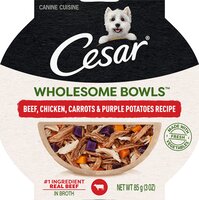
Cesar
Wholesome Bowls
Beef, Chicken, Carrots & Purple Potatoes Recipe
Cesar
Wholesome Bowls Beef, Chicken, Carrots & Purple Potatoes Recipe
First Five Ingredients
beefwater
chicken
carrot
purple potato
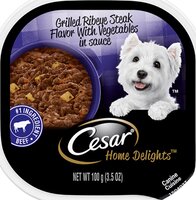
Cesar
Home Delights
Grilled Ribeye Steak Flavor With Vegetables In Sauce
Cesar
Home Delights Grilled Ribeye Steak Flavor With Vegetables In Sauce
First Five Ingredients
beefchicken broth
water
carrot
chicken
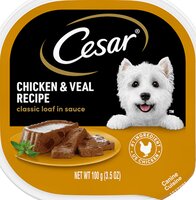
Cesar
Classic Loaf In Sauce
Chicken & Veal Recipe
Cesar
Classic Loaf In Sauce Chicken & Veal Recipe
First Five Ingredients
chickenchicken liver
beef lung
chicken broth
water
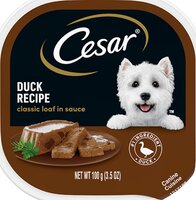
Cesar
Classic Loaf In Sauce
Duck Recipe
Cesar
Classic Loaf In Sauce Duck Recipe
First Five Ingredients
duckchicken liver
beef lung
chicken broth
water
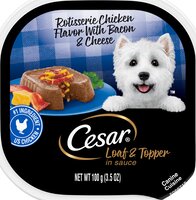
Cesar
Loaf & Topper In Sauce
Rotisserie Chicken Flavor With Bacon & Cheese
Cesar
Loaf & Topper In Sauce Rotisserie Chicken Flavor With Bacon & Cheese
First Five Ingredients
chickenchicken broth
water
chicken liver
pork by-products
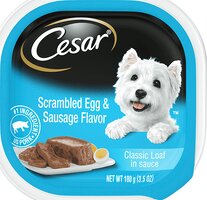
Cesar
Classic Loaf In Sauce
Scrambled Egg & Sausage Flavor
Cesar
Classic Loaf In Sauce Scrambled Egg & Sausage Flavor
First Five Ingredients
porkchicken liver
beef lung
chicken broth
water
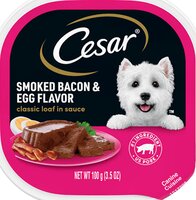
Cesar
Classic Loaf In Sauce
Smoked Bacon & Egg Flavor
Cesar
Classic Loaf In Sauce Smoked Bacon & Egg Flavor
First Five Ingredients
porkchicken liver
beef lung
chicken broth
water
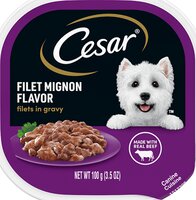
Cesar
Filets In Sauce
Filet Mignon Flavor
Cesar
Filets In Sauce Filet Mignon Flavor
First Five Ingredients
waterchicken
chicken liver
beef
animal plasma
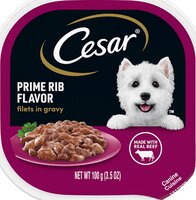
Cesar
Filets In Gravy
Prime Rib Flavor
Cesar
Filets In Gravy Prime Rib Flavor
First Five Ingredients
waterchicken
chicken liver
beef
animal plasma
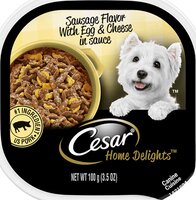
Cesar
Home Delights
Sausage Flavor With Egg & Cheese In Sauce
Cesar
Home Delights Sausage Flavor With Egg & Cheese In Sauce
First Five Ingredients
porkchicken broth
water
chicken
chicken liver
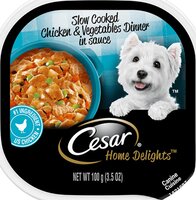
Cesar
Home Delights
Slow Cooked Chicken & Vegetables Dinner In Sauce
Cesar
Home Delights Slow Cooked Chicken & Vegetables Dinner In Sauce
First Five Ingredients
chickenchicken broth
water
chicken liver
potato
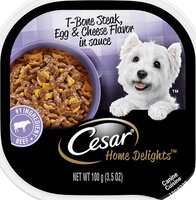
Cesar
Home Delights
T-Bone Steak, Egg & Cheese Flavor In Sauce
Cesar
Home Delights T-Bone Steak, Egg & Cheese Flavor In Sauce
First Five Ingredients
waterchicken
chicken liver
wheat flour
animal plasma
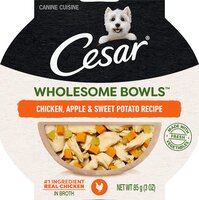
Cesar
Wholesome Bowls
Chicken, Apple & Sweet Potato Recipe
Cesar
Wholesome Bowls Chicken, Apple & Sweet Potato Recipe
First Five Ingredients
chickenwater
apple
sweet potato
soybean oil
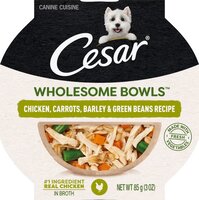
Cesar
Wholesome Bowls
Chicken, Carrots, Barley & Green Beans Recipe
Cesar
Wholesome Bowls Chicken, Carrots, Barley & Green Beans Recipe
First Five Ingredients
chickenwater
carrot
barley
green bean
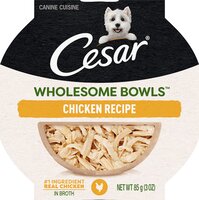
Cesar
Wholesome Bowls
Chicken Recipe
Cesar
Wholesome Bowls Chicken Recipe
First Five Ingredients
chickenwater
soybean oil
tapioca starch
powdered cellulose
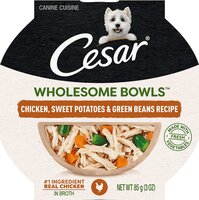
Cesar
Wholesome Bowls
Chicken, Sweet Potatoes & Green Beans Recipe
Cesar
Wholesome Bowls Chicken, Sweet Potatoes & Green Beans Recipe
First Five Ingredients
chickenwater
sweet potato
green bean
soybean oil
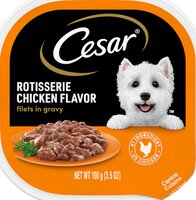
Cesar
Filets In Gravy
Rotisserie Chicken Flavor
Cesar
Filets In Gravy Rotisserie Chicken Flavor
First Five Ingredients
chickenchicken broth
water
chicken liver
animal plasma
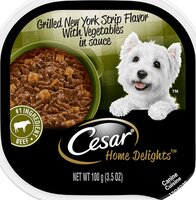
Cesar
Home Delights
Grilled New York Strip Steak Flavor With Vegetables In Sauce
Cesar
Home Delights Grilled New York Strip Steak Flavor With Vegetables In Sauce
First Five Ingredients
beefchicken broth
water
chicken
potato
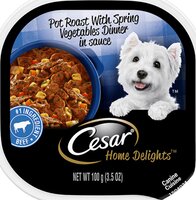
Cesar
Home Delights
Pot Roast With Spring Vegetables Dinner In Sauce
Cesar
Home Delights Pot Roast With Spring Vegetables Dinner In Sauce
First Five Ingredients
beefchicken broth
water
carrot
chicken
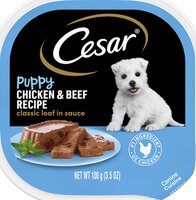
Cesar
Classic Loaf In Sauce
Chicken & Beef Recipe For Puppies
Cesar
Classic Loaf In Sauce Chicken & Beef Recipe For Puppies
First Five Ingredients
chickenchicken liver
beef lung
beef by-products
chicken broth
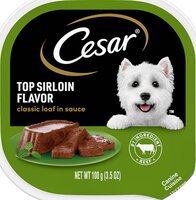
Cesar
Classic Loaf In Sauce
Top Sirloin Flavor
Cesar
Classic Loaf In Sauce Top Sirloin Flavor
First Five Ingredients
beefchicken liver
beef lung
chicken broth
water
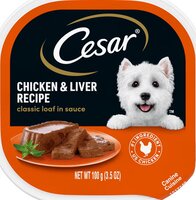
Cesar
Classic Loaf In Sauce
Chicken & Liver Recipe
Cesar
Classic Loaf In Sauce Chicken & Liver Recipe
First Five Ingredients
chickenchicken liver
beef lung
chicken broth
water
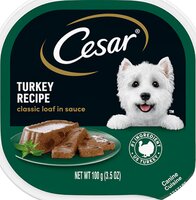
Cesar
Classic Loaf In Sauce
Turkey Recipe
Cesar
Classic Loaf In Sauce Turkey Recipe
First Five Ingredients
turkeychicken liver
beef lung
chicken broth
water
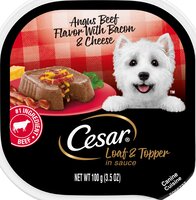
Cesar
Loaf & Topper In Sauce
Angus Beef Flavor With Bacon & Cheese
Cesar
Loaf & Topper In Sauce Angus Beef Flavor With Bacon & Cheese
First Five Ingredients
beefchicken broth
water
chicken liver
pork by-products
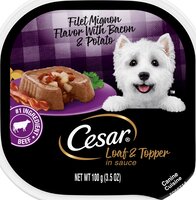
Cesar
Loaf & Topper In Sauce
Filet Mignon Flavor With Bacon & Potato
Cesar
Loaf & Topper In Sauce Filet Mignon Flavor With Bacon & Potato
First Five Ingredients
beefchicken broth
water
chicken liver
pork by-products
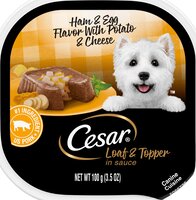
Cesar
Loaf & Topper In Sauce
Ham & Egg Flavor With Potato & Cheese
Cesar
Loaf & Topper In Sauce Ham & Egg Flavor With Potato & Cheese
First Five Ingredients
porkchicken broth
water
chicken liver
pork by-products
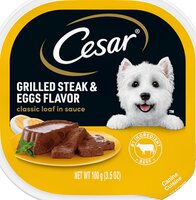
Cesar
Classic Loaf In Sauce
Grilled Steak & Eggs Flavor
Cesar
Classic Loaf In Sauce Grilled Steak & Eggs Flavor
First Five Ingredients
beefchicken liver
beef lung
chicken broth
water
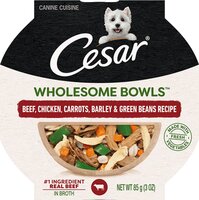
Cesar
Wholesome Bowls
Beef, Chicken, Carrots, Barley & Green Beans Recipe
Cesar
Wholesome Bowls Beef, Chicken, Carrots, Barley & Green Beans Recipe
First Five Ingredients
beefwater
chicken
carrot
barley
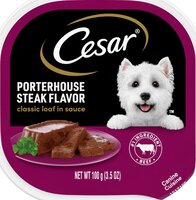
Cesar
Classic Loaf In Sauce
Porterhouse Steak Flavor
Cesar
Classic Loaf In Sauce Porterhouse Steak Flavor
First Five Ingredients
beefchicken liver
beef lung
chicken broth
water
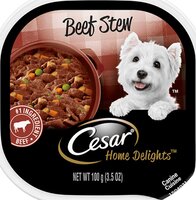
Cesar
Home Delights
Beef Stew
Cesar
Home Delights Beef Stew
First Five Ingredients
beefchicken broth
water
chicken
potato
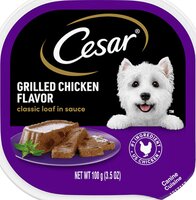
Cesar
Classic Loaf In Sauce
Grilled Chicken Flavor
Cesar
Classic Loaf In Sauce Grilled Chicken Flavor
First Five Ingredients
chickenchicken liver
beef lung
chicken broth
water
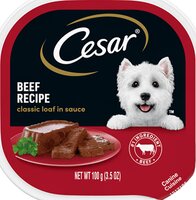
Cesar
Classic Loaf In Sauce
Beef Recipe
Cesar
Classic Loaf In Sauce Beef Recipe
First Five Ingredients
beefchicken liver
beef lung
chicken broth
water
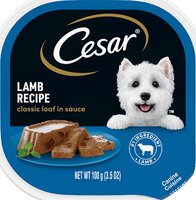
Cesar
Classic Loaf In Sauce
Lamb Recipe
Cesar
Classic Loaf In Sauce Lamb Recipe
First Five Ingredients
lambchicken liver
beef lung
chicken broth
water
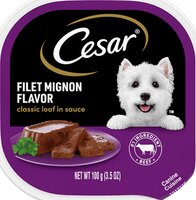
Cesar
Classic Loaf In Sauce
Filet Mignon Flavor
Cesar
Classic Loaf In Sauce Filet Mignon Flavor
First Five Ingredients
beefchicken liver
beef lung
chicken broth
water
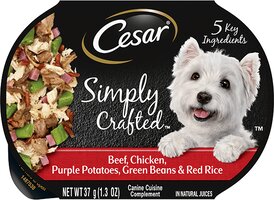
Cesar
Simply Crafted
Beef, Chicken, Purple Potatoes, Green Beans & Red Rice
Cesar
Simply Crafted Beef, Chicken, Purple Potatoes, Green Beans & Red Rice
First Five Ingredients
beefchicken
purple potato
green bean
red rice
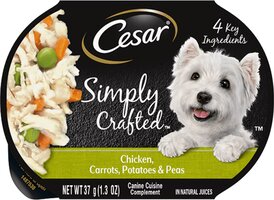
Cesar
Simply Crafted
Chicken, Carrots, Potatoes & Peas
Cesar
Simply Crafted Chicken, Carrots, Potatoes & Peas
First Five Ingredients
chickencarrot
potato
pea
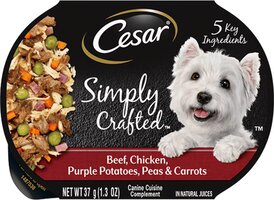
Cesar
Simply Crafted
Beef, Chicken, Purple Potatoes, Peas & Carrots
Cesar
Simply Crafted Beef, Chicken, Purple Potatoes, Peas & Carrots
First Five Ingredients
beefchicken
purple potato
pea
carrot
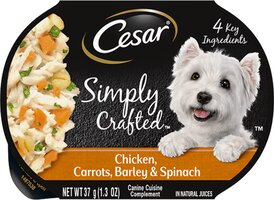
Cesar
Simply Crafted
Chicken, Carrots, Barley & Spinach
Cesar
Simply Crafted Chicken, Carrots, Barley & Spinach
First Five Ingredients
chickencarrot
barley
water
spinach
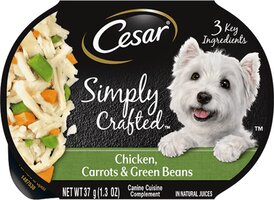
Cesar
Simply Crafted
Chicken, Carrots & Green Beans
Cesar
Simply Crafted Chicken, Carrots & Green Beans
First Five Ingredients
chickencarrot
green bean
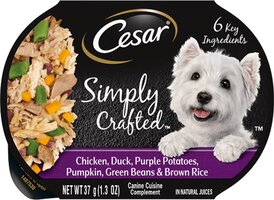
Cesar
Simply Crafted
Chicken, Duck, Purple Potatoes, Pumpkin, Green Beans & Brown Rice
Cesar
Simply Crafted Chicken, Duck, Purple Potatoes, Pumpkin, Green Beans & Brown Rice
First Five Ingredients
chickenduck
purple potato
pumpkin
green bean
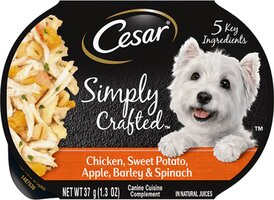
Cesar
Simply Crafted
Chicken, Sweet Potato, Apple, Barley & Spinach
Cesar
Simply Crafted Chicken, Sweet Potato, Apple, Barley & Spinach
First Five Ingredients
chickensweet potato
apple
water
barley
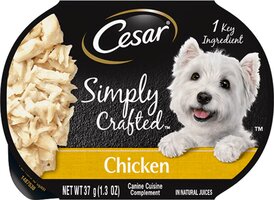
Cesar
Simply Crafted
Chicken
Cesar
Simply Crafted Chicken
First Five Ingredients
chickenwater
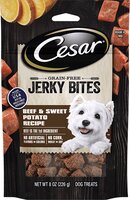
Cesar
Grain-Free Jerky Bites
Beef & Sweet Potato Recipe
Cesar
Grain-Free Jerky Bites Beef & Sweet Potato Recipe
First Five Ingredients
beefdried potato
glycerin
dried sweet potato
brown sugar
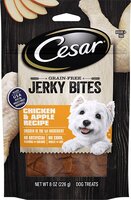
Cesar
Grain-Free Jerky Bites
Chicken & Apple Recipe
Cesar
Grain-Free Jerky Bites Chicken & Apple Recipe
First Five Ingredients
chickendried potato
glycerin
peach
dried apple
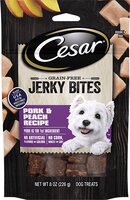
Cesar
Grain-Free Jerky Bites
Pork & Peach Recipe
Cesar
Grain-Free Jerky Bites Pork & Peach Recipe
First Five Ingredients
porkchicken
dried potato
glycerin
peach
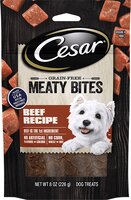
Cesar
Grain-Free Meaty Bites
Beef Recipe
Cesar
Grain-Free Meaty Bites Beef Recipe
First Five Ingredients
beefdried potato
glycerin
brown sugar
salt
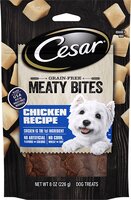
Cesar
Grain-Free Meaty Bites
Chicken Recipe
Cesar
Grain-Free Meaty Bites Chicken Recipe
First Five Ingredients
chickendried potato
glycerin
brown sugar
salt
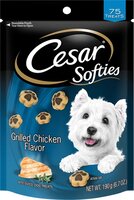
Cesar
Softies
Grilled Chicken Flavor
Cesar
Softies Grilled Chicken Flavor
First Five Ingredients
rice flourgrilled chicken flavor
wheat flour
glycerin
animal fat
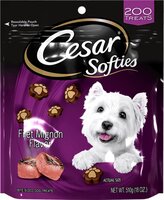
Cesar
Softies
Filet Mignon Flavor
Cesar
Softies Filet Mignon Flavor
First Five Ingredients
chickenrice flour
wheat flour
glycerin
sugar
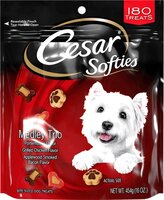
Cesar
Softies
Medley Trio
Cesar
Softies Medley Trio
First Five Ingredients
chickenrice flour
wheat flour
glycerin
sugar
